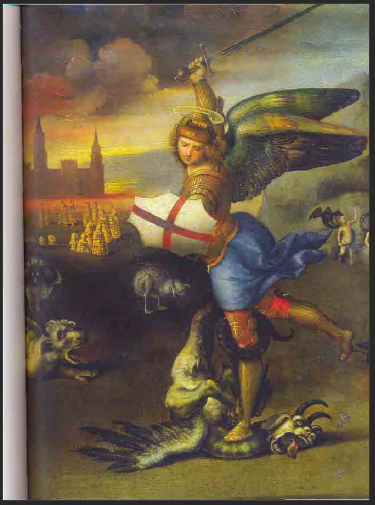St. Michael by Raphael (1504-1505)
In Raphael’s artwork, St. Michael, the archangel is depicted as a young man defeating a monster. The painting provides a striking contrast between the handsome, powerful, youthful archangel and his hideous adversary. Michael’s body is adorned with a halo and wings, encircled by Hell’s gloomy and spirited depths (Eco, 2007). There are many devils surrounding him and beneath his feet. St. Michael is equipped with a big sword and a shield for combating any devil suffering in his vicinity. In addition, angels are shown in the artwork, and all the devils following him are in agony.
The artwork depicts naked robbers assaulted by shadowy entities resembling snakes and birds. Demons push the hypocrites to advance toward the castle on fire as they emerge from the earth wearing lead robes. There are more grotesque monsters, and St. Michael has defeated the dragon. Additionally, he has defeated other evil forces, as demonstrated by the left-hand demon depicted as suffering like the beast under his feet (Eco, 2007). The archangel’s shield mimics a cross and is prominently shown in the picture. The halo above his head denotes his deity and authority over evil forces.
To conclude, the artwork depicts archangel Michael defeating a symbolic personification of the wicked and the insurgent angels. It can be assumed that he casts them from heaven and condemns them to earth. Raphael expanded upon the standard picture of Hell by adding details from Dante’s Inferno, from Dante’s renowned Devine Comedy, in which he describes the torment inflicted upon hypocrites and scoundrels.

History of Beauty Edited by Umberto Eco (1470)
In this artwork, St. George saves a princess from a monster carrying a plague that has spread fear over a city. Uccello accurately captures the poignant moment in which St. George spears the dragon. A storm surrounds him, and the tip of his spear aligns with the storm’s center, showing that supernatural influence made the dragon’s effortless destruction possible (Eco, 2010). The dragon lived in a cave, the form of which echoes the dragon’s shape like pieces of a puzzle. The princess is shown on the dragon’s right, presenting a belt in place of her body to tame the beast and guide him into the capital.
The absence of shadows diverts attention from realism, but the dragon and horse depictions demonstrate exceptional anatomical ability. The princess seems nearly serene as she utilizes her belt as a chain to capture the injured dragon, and Saint George appears to eliminate a pesky bug instead of destroying a frightening beast (Eco, 2010). At the vital point of the drama, the juxtaposition of the color palette and the absence of emotional expression in the actors give a tableau-like appearance instead of a violent sequence. Nevertheless, the contrast between the painting and the dragon itself is striking.
Despite the subtle yet tense action in the composition, Saint George creates a perspective that renders the piece captivating to the eyes. To begin, Uccello has decided to depict the dragon in the likeness of a Wyvern. A Wyvern possesses the head and wings of a dragon, the body and hind legs of a reptile, and a diamond-shaped or arrow-shaped tail. These are often connected to emblems and relate to the magnificence displayed by the heroic white horse and the fully armed Saint. Second, it may signify the creature’s inherent vulnerability because its wings have butterfly-like patterns.
References
Eco, E. (2007). On ugliness. (A McEwen, Trans). Rizzoli.
Eco, E. (2010). On beauty. (A McEwen, Trans). Secker & Warburg.